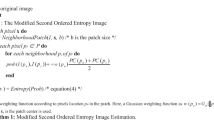Abstract
We propose a new two-dimensional structural representation method for registration of multimodal images by using the local structural symmetry of images, which is similar at different modalities. The symmetry is measured in various orientations and the best is mapped and used for the representation image. The optimum performance is obtained when using only two different orientations, which is called binary dominant symmetry representation (BDSR). This representation is highly robust to noise and intensity non-uniformity. We also propose a new objective function based on L2 distance with low sensitivity to the overlapping region. Then, five different meta-heuristic algorithms are comparatively applied. Two of them have been used for the first time on image registration. BDSR remarkably outperforms the previous successful representations, such as entropy images, self-similarity context, and modality-independent local binary pattern, as well as mutual information-based registration, in terms of success rate, runtime, convergence error, and representation construction.















Similar content being viewed by others
References
Wells WM III, Viola P, Atsumi H, Nakajima S, Kikinis R (1996) Multi-modal volume registration by maximization of mutual information. Med Image Anal 1(1):35–51
Andronache A, von Siebenthal M, Székely G, Cattin P (2008) Non-rigid registration of multi-modal images using both mutual information and cross-correlation. Med Image Anal 12(1):3–15
Studholme C, Hill DL, Hawkes DJ (1999) An overlap invariant entropy measure of 3D medical image alignment. Pattern Recogn 32(1):71–86
Pluim JPW, Maintz JBA, Viergever MA (2000) Image registration by maximization of combined mutual information and gradient information. IEEE Trans Med Imaging 19(8):809–814
Liao YL, Sun YN, Guo WY, Chou YH, Hsieh JC, Wu YT (2011) A hybrid strategy to integrate surface-based and mutual-information-based methods for co-registering brain SPECT and MR images. Med Biol Eng Compu 49(6):671–685
Wu G, Kim M, Wang Q, Munsell BC, Shen D (2015) Scalable high-performance image registration framework by unsupervised deep feature representations learning. IEEE Trans Biomed Eng 63(7):1505–1516
Wachinger C, Navab N (2012) Entropy and Laplacian images: structural representations for multi-modal registration. Med Image Anal 16(1):1–17
Razlighi QR, Kehtarnavaz N, Yousefi S (2013) Evaluating similarity measures for brain image registration. J Vis Commun Image Represent 24(7):977–987
Fuerst B, Wein W, Müller M, Navab N (2014) Automatic ultrasound–MRI registration for neurosurgery using the 2D and 3D LC2 Metric. Med Image Anal 18(8):1312–1319
Chen Z, Xu Z, Gui Q, Yang X, Cheng Q, Hou W, Ding M (2020) Self-learning based medical image representation for rigid real-time and multimodal slice-to-volume registration. Inf Sci 541:502–515
Zhu X, Ding M, Huang T, Jin X, Zhang X (2018) PCANet-based structural representation for nonrigid multimodal medical image registration. Sensors 18(5):1477
Heinrich MP, Jenkinson M, Bhushan M, Matin T, Gleeson FV, Brady M, Schnabel JA (2012) MIND: modality independent neighbourhood descriptor for multi-modal deformable registration. Med Image Anal 16(7):1423–1435
Heinrich MP, Jenkinson M, Papież BW, Brady M, Schnabel JA (2013) Towards realtime multimodal fusion for image-guided interventions using self-similarities. In: International conference on medical image computing and computer-assisted intervention (pp 187–194). Springer, Berlin, Heidelberg
Jiang D, Shi Y, Yao D, Wang M, Song Z (2016) miLBP: a robust and fast modality-independent 3D LBP for multimodal deformable registration. Int J Comput Assist Radiol Surg 11(6):997–1005
Wong A, Orchard J (2009) Robust multimodal registration using local phase-coherence representations. J Signal Process Syst 54(1–3):89
Li Z, Mahapatra D, Tielbeek JA, Stoker J, van Vliet LJ, Vos FM (2015) Image registration based on autocorrelation of local structure. IEEE Trans Med Imaging 35(1):63–75
Sotiras A, Davatzikos C, Paragios N (2013) Deformable medical image registration: a survey. IEEE Trans Med Imaging 32(7):1153
Chen Y, He F, Li H, Zhang D, Wu Y (2020) A full migration BBO algorithm with enhanced population quality bounds for multimodal biomedical image registration. Appl Soft Comput 93:106335
Liang J, Liu X, Huang K, Li X, Wang D, Wang X (2013) Automatic registration of multisensor images using an integrated spatial and mutual information (SMI) metric. IEEE Trans Geosci Remote Sens 52(1):603–615
Li T, Pan Q, Gao L, Li P (2017) Differential evolution algorithm-based range image registration for free-form surface parts quality inspection. Swarm Evol Comput 36:106–123
Kovesi P (1997) Symmetry and asymmetry from local phase. In Tenth Australian joint conference on artificial intelligence (vol 190, pp 2–4). Citeseer
Kovesi P (1999) Image features from phase congruency. Videre: J Comput Vis Res 1(3):1–26
Johnson KA, Becker JA (1999) The whole brain, Atlas, Harvard Medical School. https://www.med.harvard.edu/aanlib. Accessed Sept. 2, 2021
McConnell Brain Imaging Center Montreal Neurological Institute, McGill University, Montreal, QC ,Canada. BrainWeb. https://brainweb.bic.mni.mcgill.ca/brainweb/. Accessed Sept. 24, 2020
Eberhart R, Kennedy J (1995) Particle swarm optimization. In Proceedings of the IEEE international conference on neural networks (vol 4, pp 1942–1948)
Storn R, Price K (1997) Differential evolution–a simple and efficient heuristic for global optimization over continuous spaces. J Global Optim 11(4):341–359
Eusuff M, Lansey K, Pasha F (2006) Shuffled frog-leaping algorithm: a memetic meta-heuristic for discrete optimization. Eng Optim 38(2):129–154
Mirjalili S, Lewis A (2016) The whale optimization algorithm. Adv Eng Softw 95:51–67
Kirkpatrick S, Gelatt CD, Vecchi MP (1983) Optimization by simulated annealing. Science 220(4598):671–680
Funding
This work received funding support from Babol Noshirvani University of Technology through grant program no. BNUT/389059/400.
Author information
Authors and Affiliations
Corresponding author
Additional information
Publisher's note
Springer Nature remains neutral with regard to jurisdictional claims in published maps and institutional affiliations.
Rights and permissions
About this article
Cite this article
Soleimani, M., Aghagolzadeh, A. & Ezoji, M. Symmetry-based representation for registration of multimodal images. Med Biol Eng Comput 60, 1015–1032 (2022). https://doi.org/10.1007/s11517-022-02515-1
Received:
Accepted:
Published:
Issue Date:
DOI: https://doi.org/10.1007/s11517-022-02515-1




